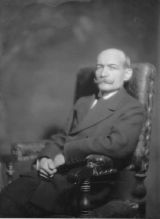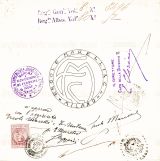Ercole Marelli & C. S.p.A.: Difference between revisions
(Add image from CDS) |
ArxCyberwolf (talk | contribs) (Added images.) |
||
| Line 8: | Line 8: | ||
Ercole Marelli | Ercole Marelli | ||
<div>EMC </div>|succeeded=Marelli Europe | <div>EMC </div>|succeeded=Marelli Europe | ||
MARELLI|image=Logomarelli.jpg}}'''Ercole Marelli & Company Società per Azioni''', also known as '''Ercole Marelli''' or '''EMC''', was a Milan, LM-based manufacturer of electric machinery, such as fans, motors, vacuum cleaners, and electromechanical sirens, founded in 1891 by electrician Ercole Marelli. While prospering in the early 20th century, various challenges ultimately resulted in the company's dissolution in 1981, although its spin-off organizations are still in operation to this day. | MARELLI|image=Logomarelli.jpg|caption=EMC's logo, likely used during the tail end of its operation.}}'''Ercole Marelli & Company Società per Azioni''', also known as '''Ercole Marelli''' or '''EMC''', was a Milan, LM-based manufacturer of electric machinery, such as fans, motors, vacuum cleaners, and electromechanical sirens, founded in 1891 by electrician Ercole Marelli. While prospering in the early 20th century, various challenges ultimately resulted in the company's dissolution in 1981, although its spin-off organizations are still in operation to this day. | ||
== History == | == History == | ||
[[File:Ercole Marelli 1919.jpg|left|thumb|219x219px|Ercole Marelli in 1919. my guy was dripped out]] | |||
Ercole Marelli was born on May 19, 1867, in Milan, Italy. At the age of 15, he apprenticed as a mechanical apprentice at a man named L. Fraschini's workshop, who was a technician from the physics office of C. Beccaria High School. His passion and aptitude soon caught the eye of Bartolomeo Cabella, director of the Italian Tecnomasio of Milan, leading Marelli to delve deeper into the field. In 1888, Marelli traveled to Asunción, Paraguay, establishing an electrical system for the Concha Sociedad plant. This marked the beginning of '''Ercole Marelli & Company S.A.''' ('''EMC''') in 1891, as Marelli returned to Milan to set up his own workshop. EMC expanded in the following years with the incorporation of engineer B. Folli into the company, who made advancements in lightning protection systems and portable electric accumulators. | Ercole Marelli was born on May 19, 1867, in Milan, Italy. At the age of 15, he apprenticed as a mechanical apprentice at a man named L. Fraschini's workshop, who was a technician from the physics office of C. Beccaria High School. His passion and aptitude soon caught the eye of Bartolomeo Cabella, director of the Italian Tecnomasio of Milan, leading Marelli to delve deeper into the field. In 1888, Marelli traveled to Asunción, Paraguay, establishing an electrical system for the Concha Sociedad plant. This marked the beginning of '''Ercole Marelli & Company S.A.''' ('''EMC''') in 1891, as Marelli returned to Milan to set up his own workshop. EMC expanded in the following years with the incorporation of engineer B. Folli into the company, who made advancements in lightning protection systems and portable electric accumulators. | ||
In 1900 or 1901, the company became a limited partnership and was renamed '''Ercole Marelli & Company'''. The dawn of the 20th century saw EMC's foray into global markets, with exports to Spain and South America, and the company extended to aviation in 1910 with Marelli filing a patent for a simple airplane design. The following years brought several patents and accolades for EMC, with at the time revolutionary inventions such as oscillating fans and induction motors cementing its legacy. Ercole Marelli's commitment culminated in royal recognition, as he was bestowed with the title of "Cavaliere del Lavoro" in 1912. | In 1900 or 1901, the company became a limited partnership and was renamed '''Ercole Marelli & Company'''. The dawn of the 20th century saw EMC's foray into global markets, with exports to Spain and South America, and the company extended to aviation in 1910 with Marelli filing a patent for a simple airplane design. The following years brought several patents and accolades for EMC, with at the time revolutionary inventions such as oscillating fans and induction motors cementing its legacy. Ercole Marelli's commitment culminated in royal recognition, as he was bestowed with the title of "Cavaliere del Lavoro" in 1912. | ||
[[File:Marchio-em-8401-8500 0097.jpg|left|thumb|161x161px|EMC's old logo, featured in the center.]] | |||
In 1919, Marelli entered a partnership with FIAT, resulting in the creation of '''Fabbrica Italiana Magneti Marelli SA''' ('''FIMM'''), which would end up breaking off from EMC entirely and today is known as '''Marelli Europe S.p.A.'''. Unfortunately, Marelli would pass away in 1922 at the age of 55 after suffering from tuberculosis. From then on, EMC's operations would be led by a man named Stefano Benni. Several branches of EMC across Europe and South America were established by 1928. | In 1919, Marelli entered a partnership with FIAT, resulting in the creation of '''Fabbrica Italiana Magneti Marelli SA''' ('''FIMM'''), which would end up breaking off from EMC entirely and today is known as '''Marelli Europe S.p.A.'''. Unfortunately, Marelli would pass away in 1922 at the age of 55 after suffering from tuberculosis. From then on, EMC's operations would be led by a man named Stefano Benni. Several branches of EMC across Europe and South America were established by 1928. | ||
| Line 24: | Line 25: | ||
== Products == | == Products == | ||
[[File:Marelli Type M6.jpg|left|thumb|160x160px|A Type M6 unit in Teramo, AB, Italy.]] | |||
=== Type M6 === | === Type M6 === | ||
Latest revision as of 23:57, 16 October 2024
Ercole Marelli & Company Società per Azioni, also known as Ercole Marelli or EMC, was a Milan, LM-based manufacturer of electric machinery, such as fans, motors, vacuum cleaners, and electromechanical sirens, founded in 1891 by electrician Ercole Marelli. While prospering in the early 20th century, various challenges ultimately resulted in the company's dissolution in 1981, although its spin-off organizations are still in operation to this day.
History

Ercole Marelli was born on May 19, 1867, in Milan, Italy. At the age of 15, he apprenticed as a mechanical apprentice at a man named L. Fraschini's workshop, who was a technician from the physics office of C. Beccaria High School. His passion and aptitude soon caught the eye of Bartolomeo Cabella, director of the Italian Tecnomasio of Milan, leading Marelli to delve deeper into the field. In 1888, Marelli traveled to Asunción, Paraguay, establishing an electrical system for the Concha Sociedad plant. This marked the beginning of Ercole Marelli & Company S.A. (EMC) in 1891, as Marelli returned to Milan to set up his own workshop. EMC expanded in the following years with the incorporation of engineer B. Folli into the company, who made advancements in lightning protection systems and portable electric accumulators.
In 1900 or 1901, the company became a limited partnership and was renamed Ercole Marelli & Company. The dawn of the 20th century saw EMC's foray into global markets, with exports to Spain and South America, and the company extended to aviation in 1910 with Marelli filing a patent for a simple airplane design. The following years brought several patents and accolades for EMC, with at the time revolutionary inventions such as oscillating fans and induction motors cementing its legacy. Ercole Marelli's commitment culminated in royal recognition, as he was bestowed with the title of "Cavaliere del Lavoro" in 1912.

In 1919, Marelli entered a partnership with FIAT, resulting in the creation of Fabbrica Italiana Magneti Marelli SA (FIMM), which would end up breaking off from EMC entirely and today is known as Marelli Europe S.p.A.. Unfortunately, Marelli would pass away in 1922 at the age of 55 after suffering from tuberculosis. From then on, EMC's operations would be led by a man named Stefano Benni. Several branches of EMC across Europe and South America were established by 1928.
Further advancements were made by EMC in the coming decade, introducing a lineup of several household appliances which were marketed under a company named Società Costruttrice di Apparecchi Elettrodomestici Marelli (SCAEM). EMC also increased production of larger machinery, such as alternators and transformers, control systems for rolling mills for major Italian steelworks, propulsion machinery for ships and equipment for trains, and electric pumps for water and reclamation works.Prior to WWII, EMC's employment was at an all time high, exceeding 5,000 people.
In 1935, Stefano Benni would be superseded by the second son of Ercole Marelli, Fermo. Stefano Benni would later become the president of FIMM and EMC's aviation branch, Areomeccanica Marelli. In 1943, over 1,000 employees of EMC went on strike in protest of the fascist Italian government as part of a wave of anti-fascist strikes, and 2 years later, EMC's factory in Sesto San Giovanni was occupied by the workers and a partisan brigade was established. The government cracked down hard on these protests, with workers participating arrested and deported, and in 2 known cases, killed.
Despite decades of innovation and success, the latter half of the 20th century posed formidable challenges for EMC. Economic fluctuations, labor disputes, and shifting market dynamics precipitated a period of restructuring and reorganization. This failed to reverse the company's decline, and the company's shareholders were forced to sell their shares. All of this culminated in a phase of liquidation in 1981, bringing an end to EMC. While the company may have ceased to exist in its original form, its lives on via several of its successor organizations, and the legacy of Ercole Marelli remains etched in the annals of history.
Products

Type M6
The Type M6 is the largest siren EMC was known to have produced, and was introduced sometime in 1937. The siren is 8-port and driven by a 6 kW 220 V 50 Hz 3 ph motor underneath the rotor and stator assembly. The motor sits upon a large pedestal mount which allows the siren to be bolted to a flat surface. The siren's circular junction box is located on the side of the motor. A large mesh screen protects the siren's intake, and is held between a large rain shield and a sound deflector above the rotor and stator. An electric heater located around the siren's rotor prevents ice from forming on the siren, and is powered by an external motor. An electromagnetic mechanism allows the siren to be silenced by cutting off the intake, although due to a lack of documentation, how exactly it does this is unknown. This mechanism, in a similar vain to the Fedelcode Model 2, allowed for Morse code signals to be produced. Although the number is dwindling, several Type M6 units exist, with most in service as fire sirens.
